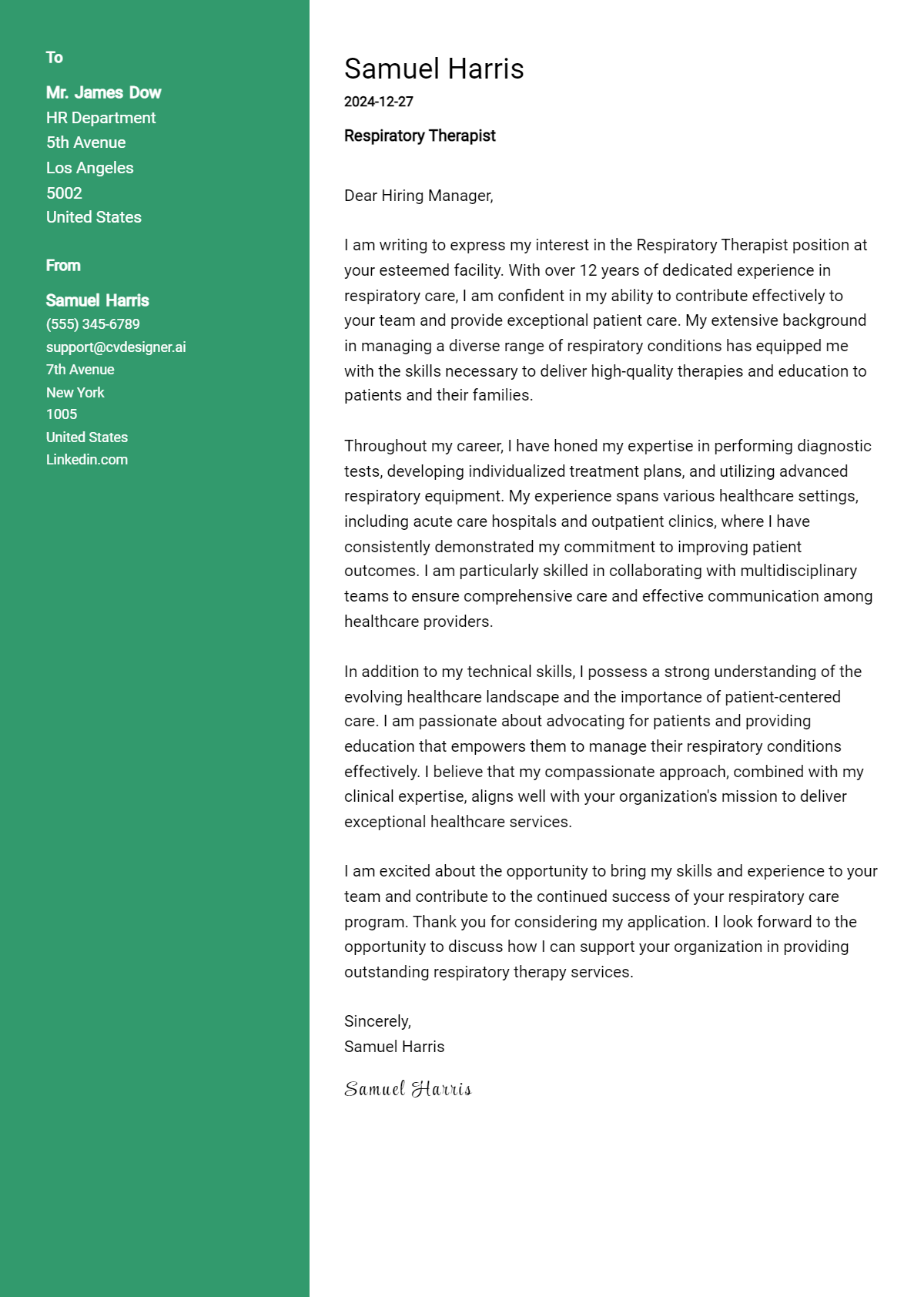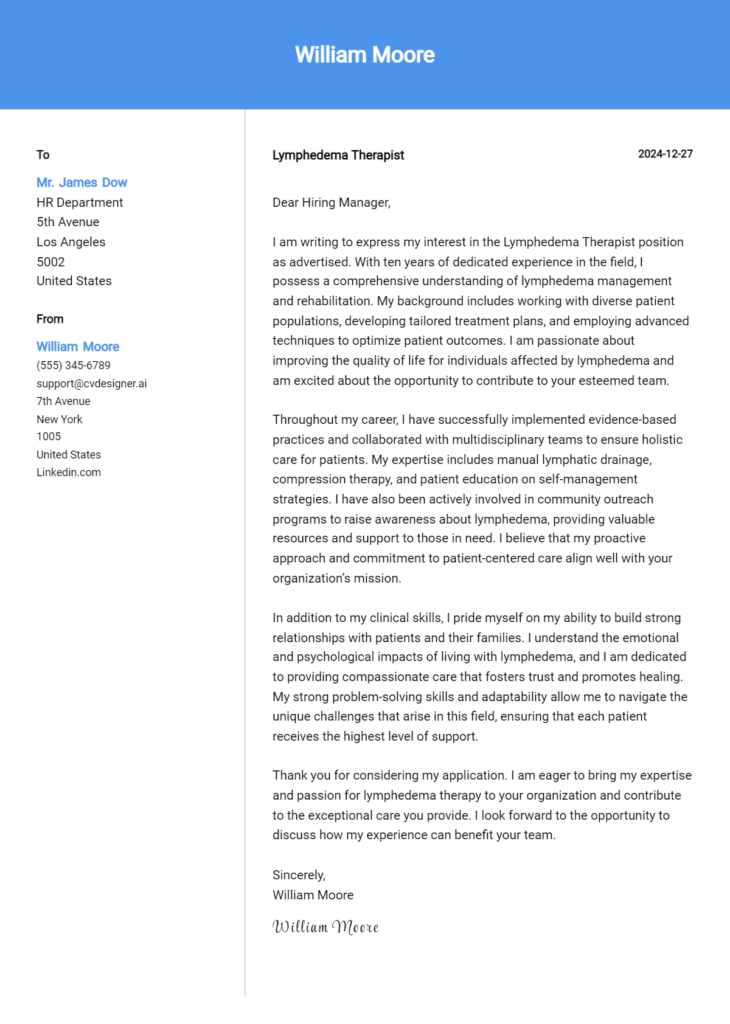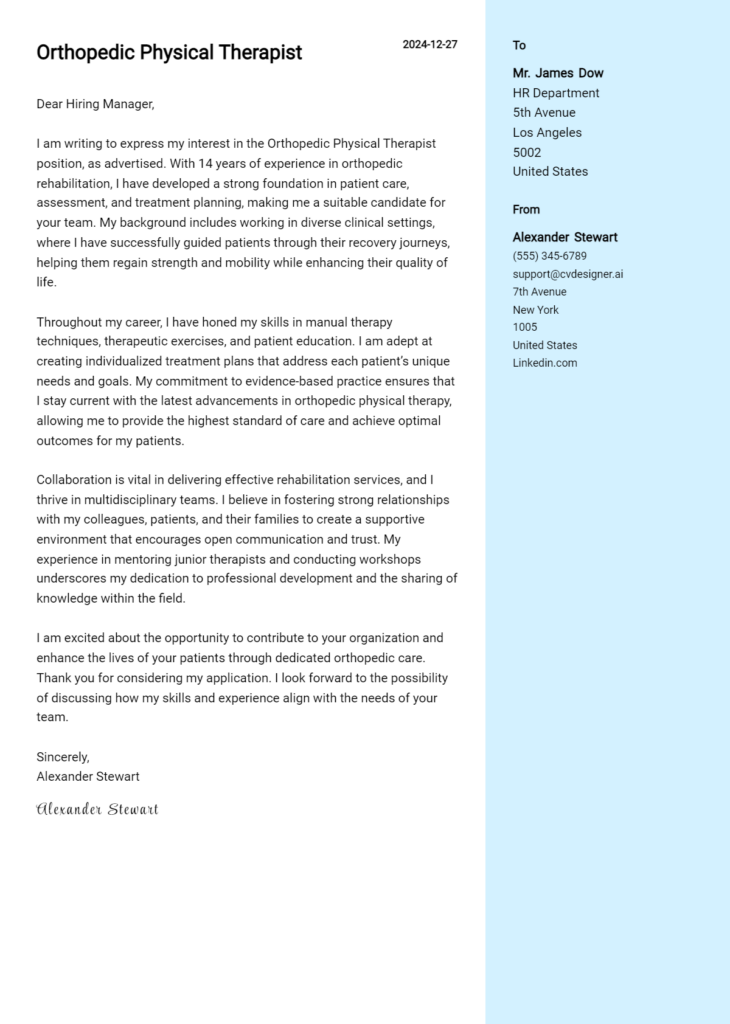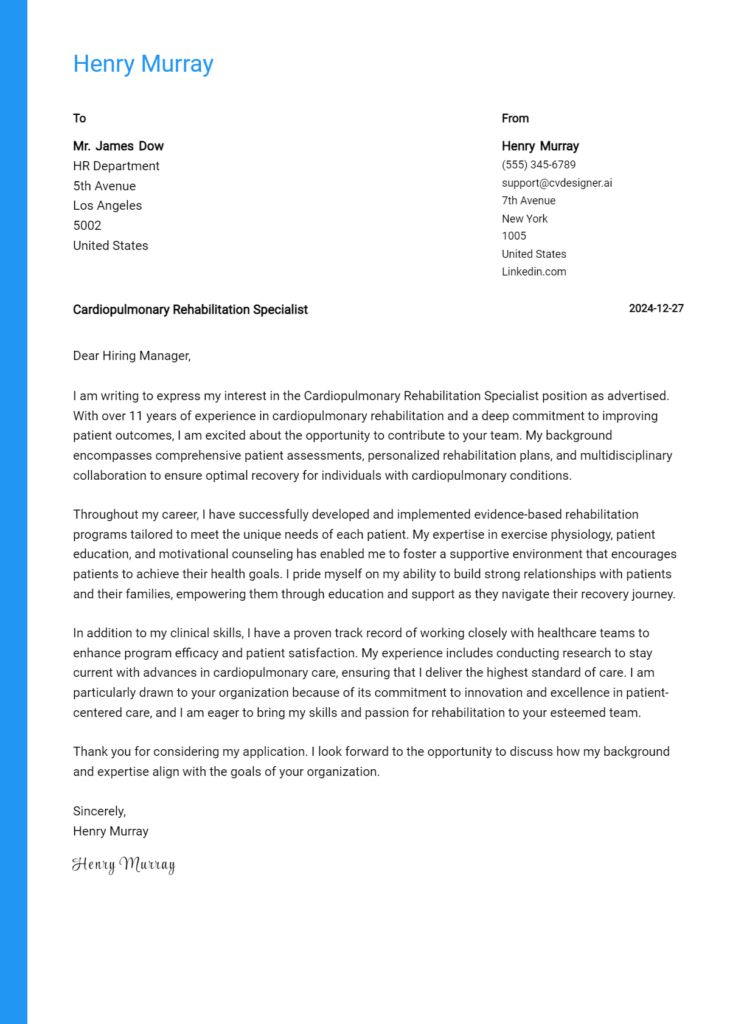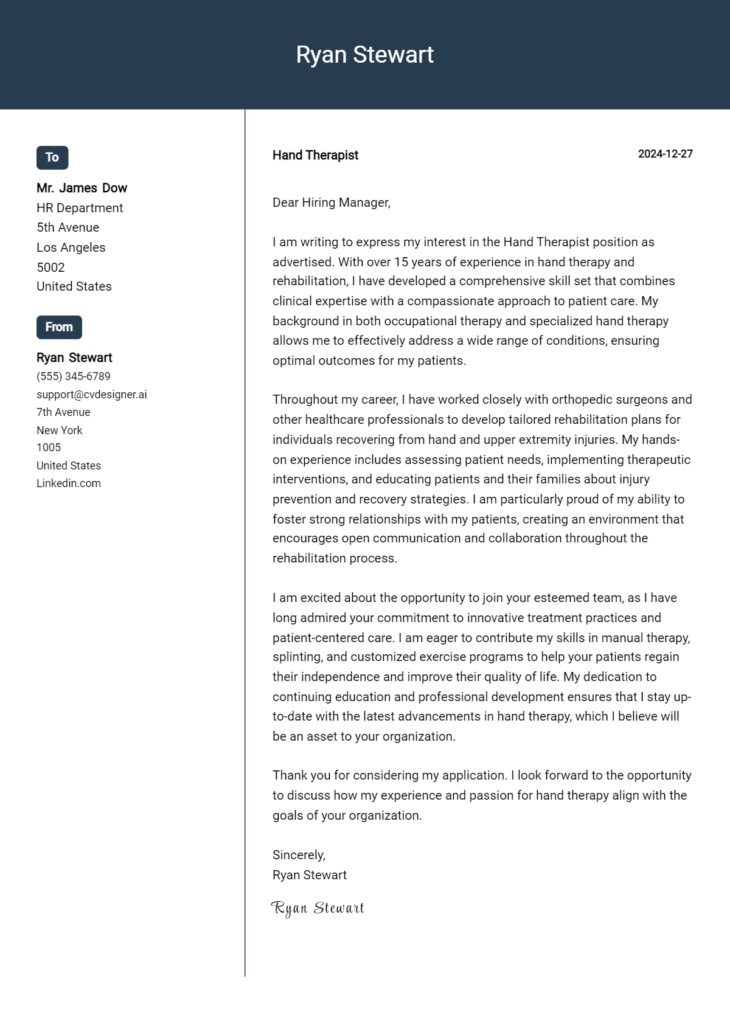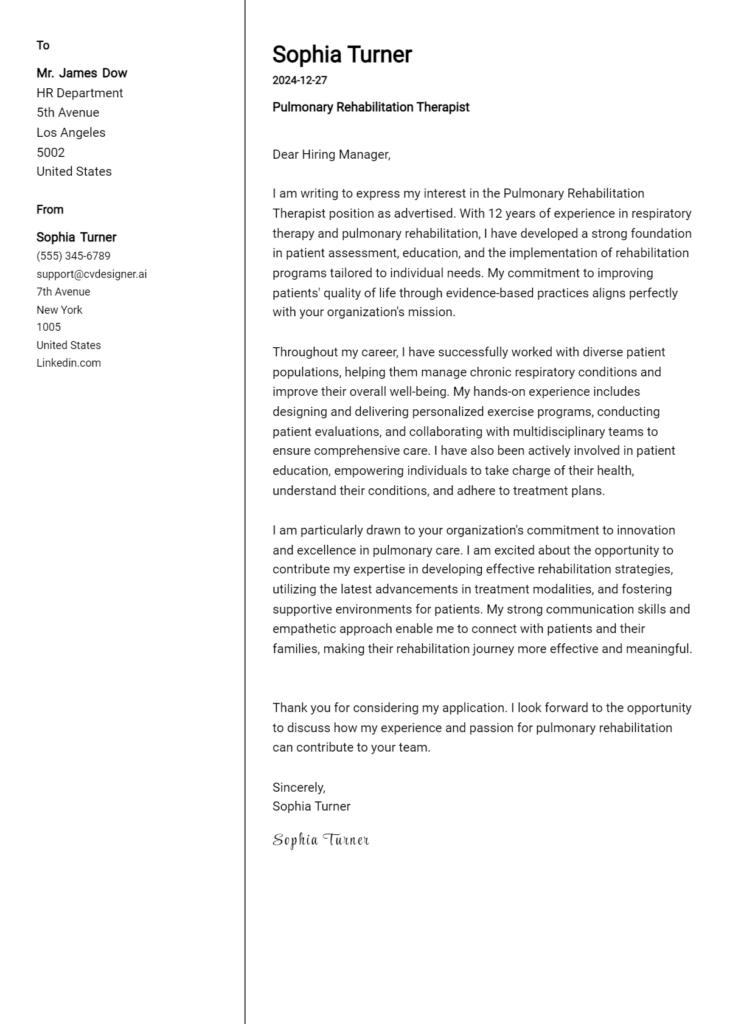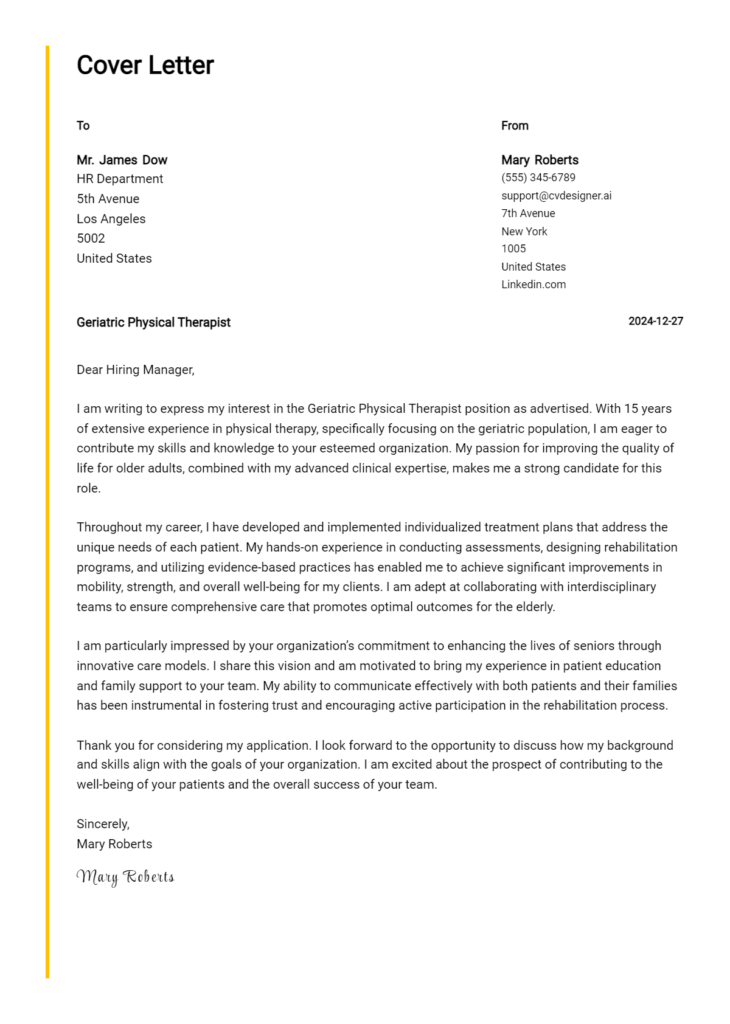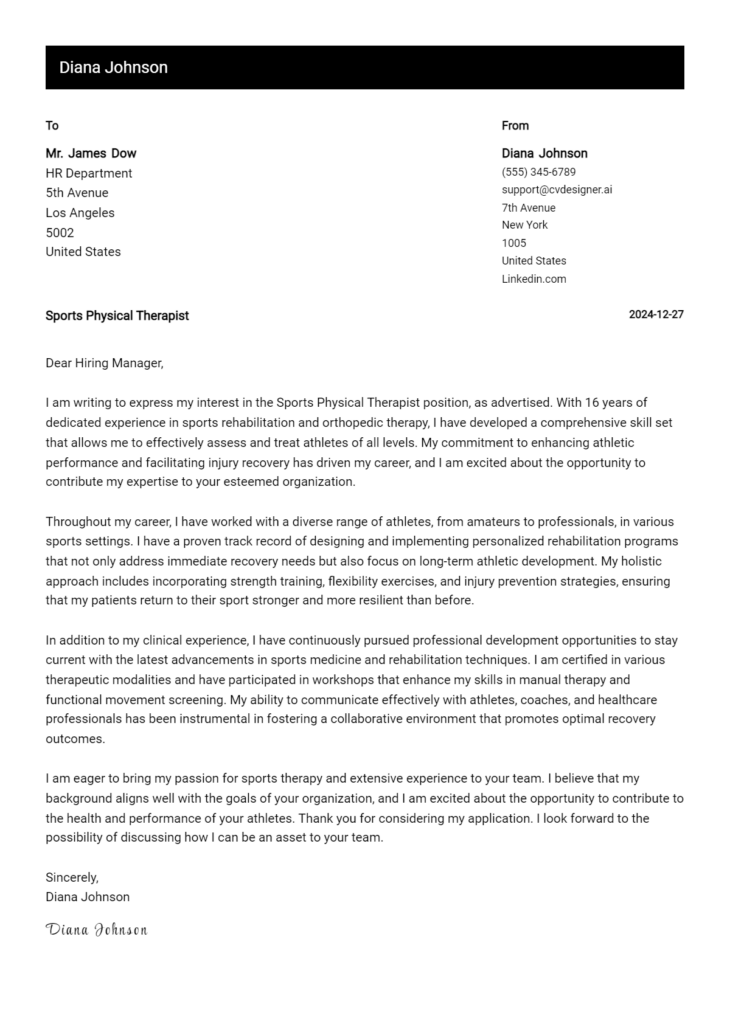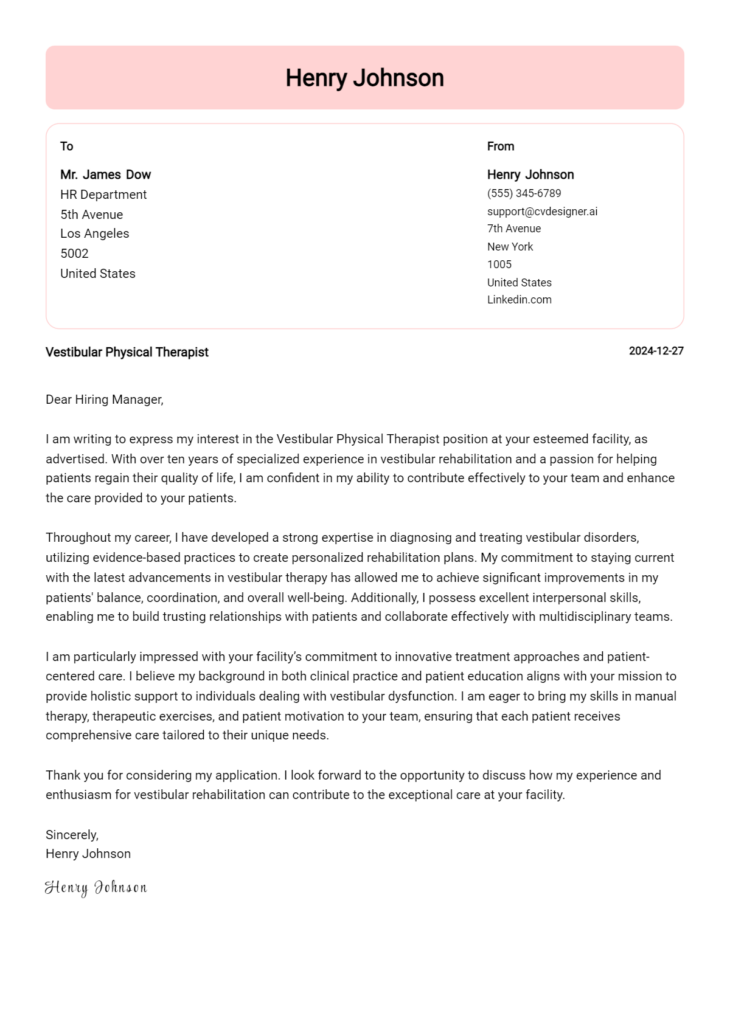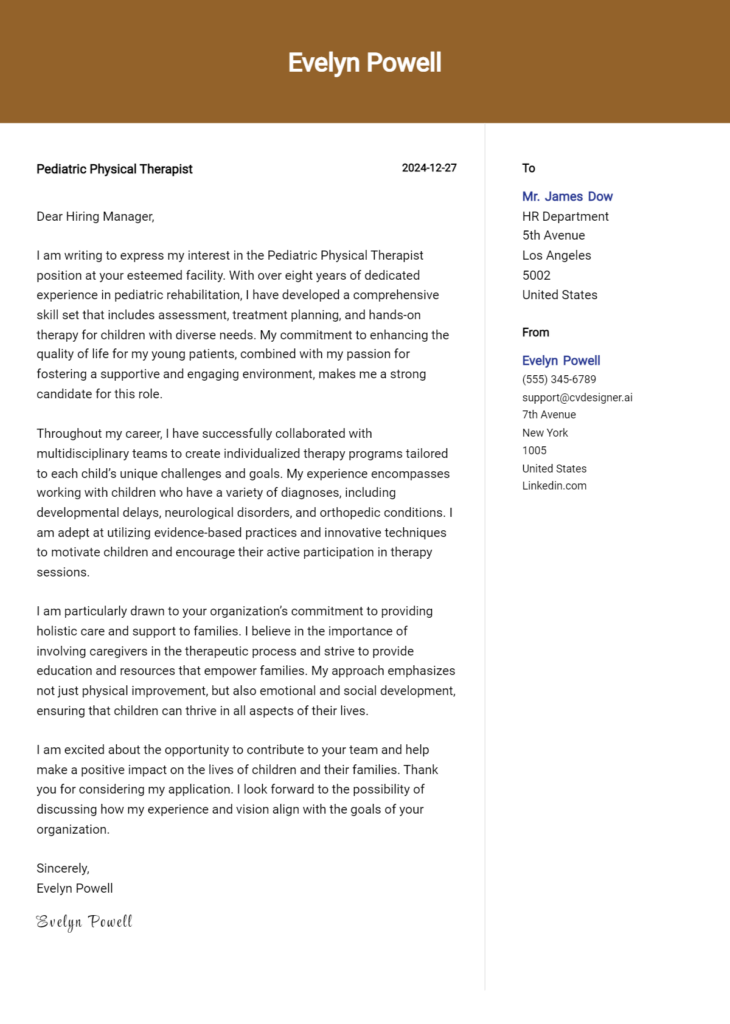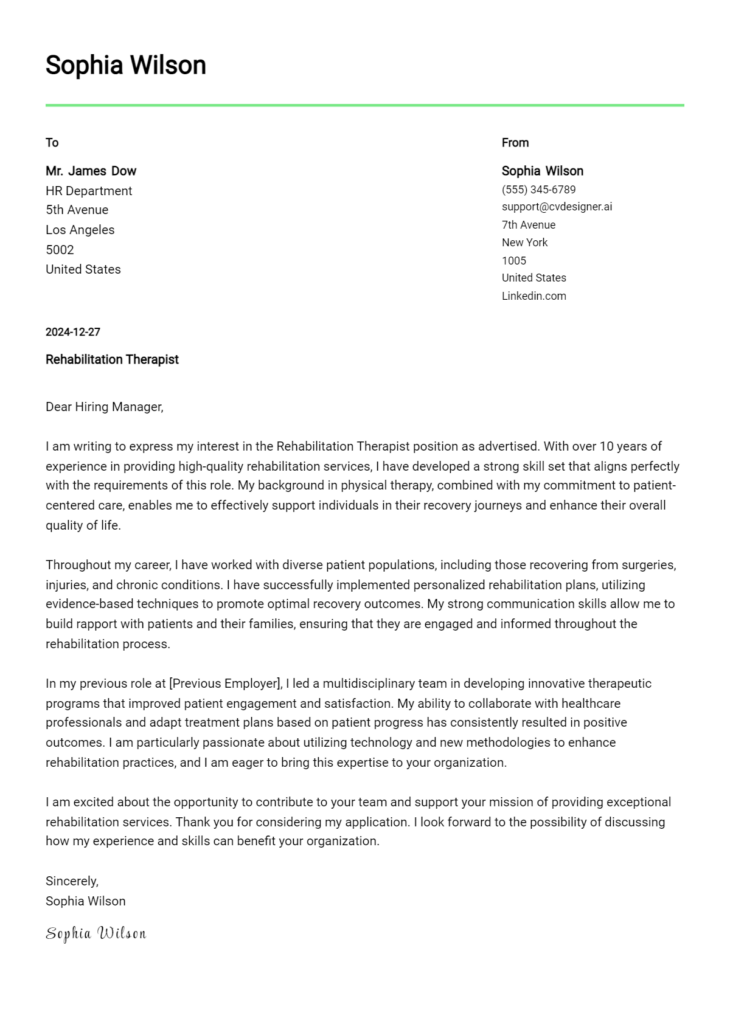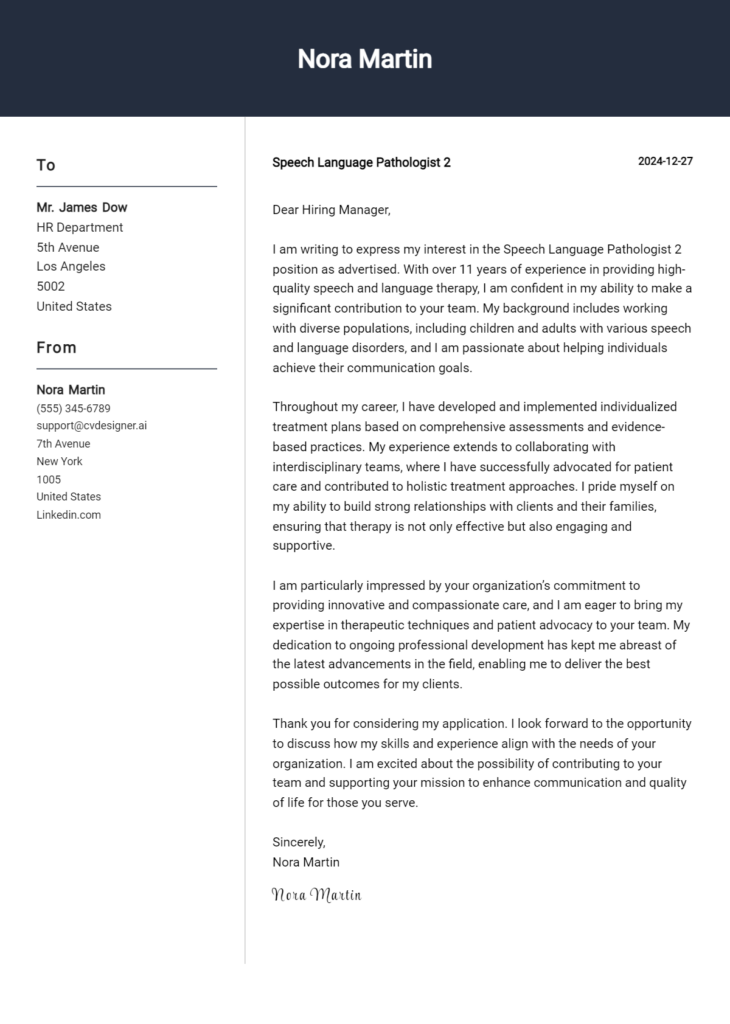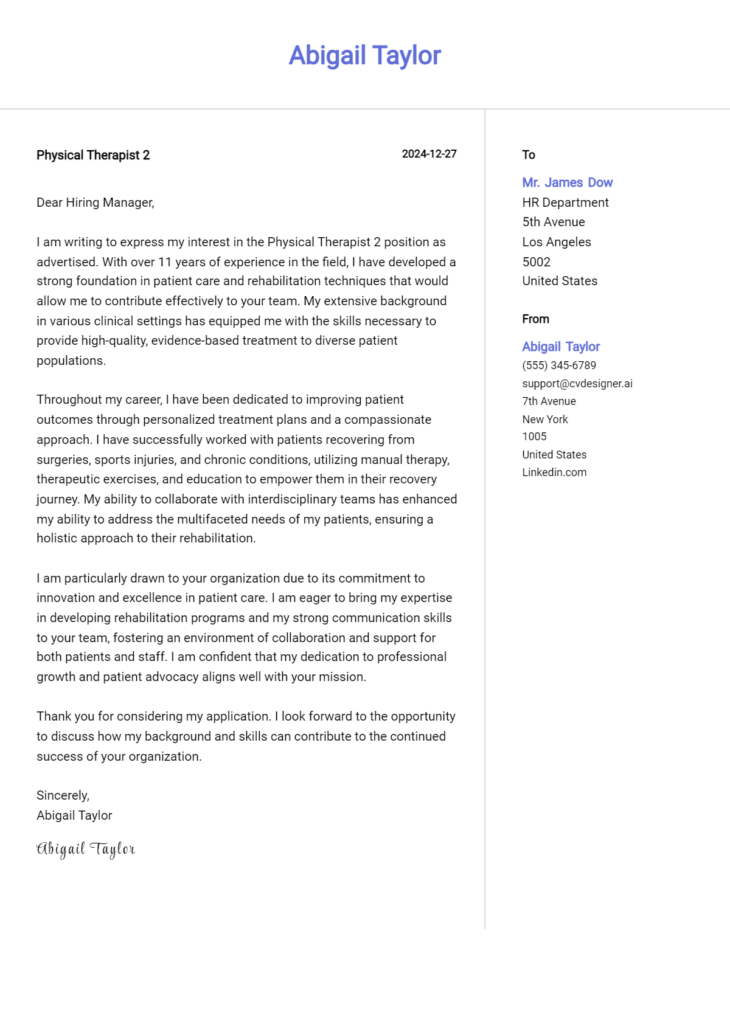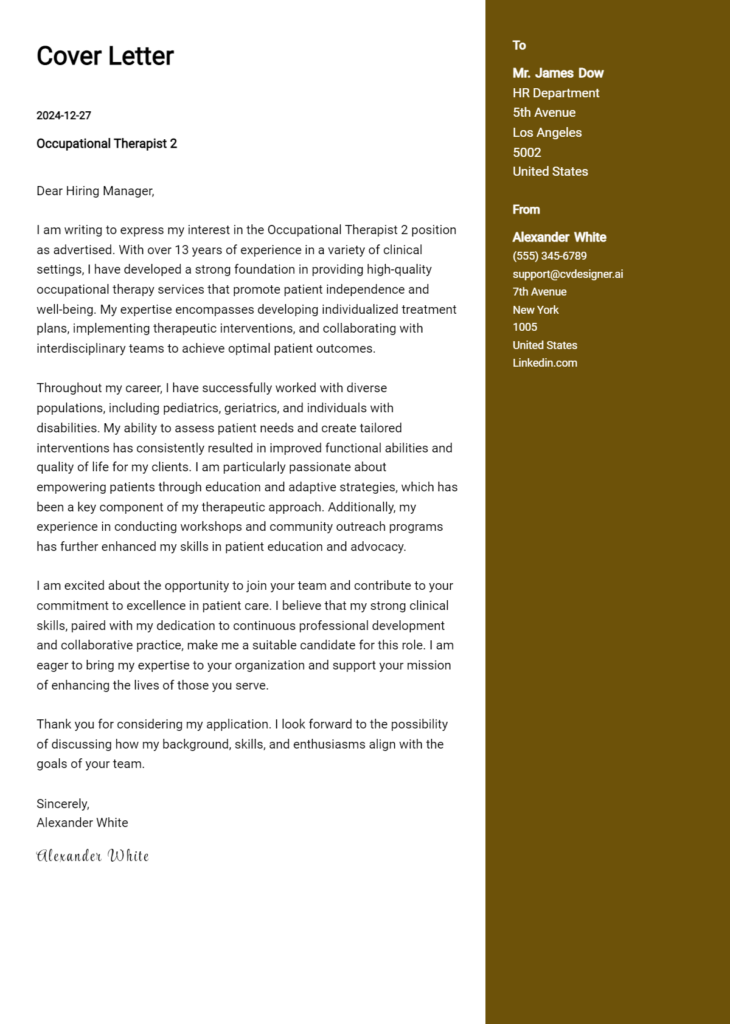Respiratory Therapist Cover Letter Examples
Explore additional Respiratory Therapist cover letter samples and guides and see what works for your level of experience or role.
How to Format a Respiratory Therapist Cover Letter?
Crafting a compelling cover letter is crucial for Respiratory Therapists as it serves as a reflection of your expertise and compassionate approach to patient care. The way you format your cover letter not only showcases your professional qualifications but also conveys your ability to communicate effectively—a key skill in the healthcare field. A well-structured cover letter can engage the hiring manager and highlight your commitment to improving patients' respiratory health.
In this guide, we'll outline the essential components of a professional cover letter, providing insights and examples tailored for Respiratory Therapists.
We'll focus on the essential components of a professional cover letter, including:
- Cover Letter Header,
- Cover Letter Greeting,
- Cover Letter Introduction,
- Cover Letter Body,
- Cover Letter Closing.
Each section plays a vital role in highlighting your qualifications and dedication to the respiratory care profession. Let’s break down each part and explain how to make your cover letter stand out.
Importance of the Cover Letter Header for a Respiratory Therapist
A well-crafted cover letter header is essential for a Respiratory Therapist as it sets the tone for the entire document and establishes professionalism. The header should include key information such as your contact details, the date, and the recipient's information, ensuring clarity and easy reference for the hiring manager. A strong header not only conveys your attention to detail but also makes it easier for employers to reach out to you. A poorly formatted header, on the other hand, can create confusion and diminish your chances of making a positive impression.
Strong Example
John Doe 1234 Breathing Lane Oxygen City, ST 12345 (123) 456-7890 johndoe@email.com [Today’s Date] Hiring Manager ABC Hospital 5678 Health St. Wellness Town, ST 67890
Weak Example
johndoe@email.com ABC Hospital 5678 Health St. Wellness Town, ST 67890
The Importance of the Cover Letter Greeting
The greeting of your cover letter is a crucial element that sets the tone for the entire document. It serves not only as the opening line but also as a demonstration of professionalism and personalization. By addressing the hiring manager directly, you establish a connection and show that you have taken the time to research the role and the organization. Avoiding generic greetings, such as "To Whom It May Concern," can make your application stand out. If the recipient's name is not readily available, a bit of effort in researching can pay off significantly. An impactful greeting can convey your enthusiasm and respect for the position, while a lackluster one can diminish the overall impression of your application.
Strong Greeting Example
Dear Ms. Johnson,
Weak Greeting Example
To Whom It May Concern,
The Importance of a Compelling Cover Letter Introduction for a Respiratory Therapist
A well-crafted cover letter introduction is essential for a Respiratory Therapist, as it sets the tone for the entire application and captures the hiring manager’s attention right from the start. This opening paragraph should not only express the candidate’s enthusiasm for the role but also highlight key skills and achievements relevant to the position. A strong introduction can make a lasting impression, encouraging the reader to delve deeper into the application, while a weak introduction may lead to an immediate dismissal of the candidate. Below are examples of both strong and weak introductions to illustrate the difference.
Strong Example
Dear [Hiring Manager's Name], As a dedicated and compassionate Respiratory Therapist with over five years of experience in diverse clinical settings, I am excited to apply for the position at [Company Name]. My background in managing complex respiratory conditions, coupled with my commitment to patient care and evidence-based practices, has equipped me with the skills to significantly contribute to your team. I am particularly drawn to [Company Name] because of its reputation for innovation in respiratory care, and I am eager to bring my expertise in [specific skill or achievement] to enhance patient outcomes.
Weak Example
To Whom It May Concern, I am writing to apply for the Respiratory Therapist position. I have some experience in this field, and I think I could do the job. I believe that working at [Company Name] would be a good opportunity for me.
Cover Letter Body for a Respiratory Therapist
The body of a cover letter for a Respiratory Therapist serves as a crucial platform for candidates to convey their unique qualifications, relevant experiences, and the specific value they can bring to a healthcare facility. This section provides an opportunity to detail key projects or accomplishments that demonstrate the candidate's expertise in managing respiratory care, collaborating with interdisciplinary teams, and ensuring optimal patient outcomes. By sharing specific examples, such as successful interventions or contributions to quality improvement initiatives, candidates can effectively illustrate their competencies and passion for patient care, ultimately making a compelling case for their candidacy.
Strong Example
In my previous role at City Hospital, I successfully led a project to implement a new protocol for managing patients with chronic obstructive pulmonary disease (COPD). This initiative resulted in a 20% reduction in readmission rates over six months, significantly improving patient outcomes. Additionally, I collaborated closely with the nursing staff to develop educational materials that empowered patients to manage their conditions more effectively at home. My commitment to enhancing respiratory care and fostering a team-oriented environment aligns perfectly with your facility's mission to provide exceptional patient-centered services.
Weak Example
I have worked as a Respiratory Therapist for several years. I am skilled in using various equipment and have helped many patients. I believe I would be a good fit for your hospital. I am looking for a new job because I want to work somewhere better.
Importance of Cover Letter Closing for a Respiratory Therapist
The closing paragraph of a cover letter is crucial as it leaves a lasting impression on the hiring manager. It should effectively summarize your qualifications, reiterate your enthusiasm for the role, and encourage the next steps, such as reviewing your resume or scheduling an interview. A strong closing conveys confidence and readiness to discuss how your skills align with the needs of the position, while a weak closing may come across as vague or disinterested.
Strong Example
Thank you for considering my application for the Respiratory Therapist position. With my extensive experience in patient care, proficiency in advanced respiratory therapies, and a genuine passion for improving patients' quality of life, I am excited about the opportunity to contribute to your team. I look forward to discussing how my skills align with your needs and would welcome the chance to further elaborate on my qualifications in an interview. Please feel free to contact me at your earliest convenience to schedule a meeting.
Weak Example
I hope you read my resume. I think I would be good at this job. Please let me know if you want to talk more. Thank you.
Crafting an effective cover letter is crucial for candidates applying for the role of a Respiratory Therapist. A well-written cover letter serves as a personal introduction, allowing you to highlight your technical skills, problem-solving abilities, and teamwork experience while showcasing your passion for continuous learning in the field. The following tips will guide you in creating a compelling cover letter that stands out to potential employers.
Tips for Writing an Effective Cover Letter as a Respiratory Therapist
Highlight Technical Skills: Begin your cover letter by showcasing your relevant technical skills. Mention your proficiency with respiratory therapy equipment, knowledge of various therapeutic techniques, and any specialized certifications. Use specific examples from your experience to illustrate how these skills have positively impacted patient care.
Demonstrate Problem-Solving Abilities: Employers value candidates who can think critically and resolve issues effectively. Share a brief story or example of a challenging situation you faced while providing respiratory care and how you approached the problem. Emphasize the results of your actions and how they benefited the patient and the healthcare team.
Showcase SDLC Knowledge: If applicable, include your understanding of the Software Development Life Cycle (SDLC) in relation to respiratory therapy. Discuss any experience you have with implementing or utilizing healthcare technology that enhances patient outcomes. This can set you apart as a candidate who is not only skilled in therapy but also tech-savvy.
Emphasize Teamwork: Respiratory Therapists often work as part of a multidisciplinary team. Highlight your ability to collaborate effectively with physicians, nurses, and other healthcare professionals. Provide examples of how your teamwork has led to improved patient care or enhanced team dynamics in previous roles.
Express Passion for Continuous Learning: The field of respiratory therapy is constantly evolving. Convey your commitment to staying updated with the latest advancements, techniques, and best practices. Mention any continuing education courses, workshops, or professional organizations you are involved with. This demonstrates your dedication to providing the best care possible and your proactive approach to professional development.
By utilizing these tips, you can create a standout cover letter that effectively communicates your qualifications and enthusiasm for the role of a Respiratory Therapist. For additional help, consider exploring cover letter templates or using a cover letter builder to streamline the writing process.
Common Mistakes to Avoid in a Respiratory Therapist Cover Letter
Crafting a compelling cover letter is essential for standing out in the competitive field of respiratory therapy. Avoiding common mistakes can significantly enhance your chances of landing an interview. Here are some frequent pitfalls to watch for:
Generic Content: Using a one-size-fits-all approach can make your application blend in with the rest. Tailor your letter to the specific job by referencing the hospital or clinic and aligning your skills with their needs.
Lack of Specific Examples: Failing to provide concrete examples of your experience may leave your qualifications unclear. Include specific achievements or cases that showcase your skills, such as successful patient outcomes or certifications.
Poor Formatting: A cluttered or unprofessional layout can distract from your message. Follow a clear cover letter format that includes proper spacing, headings, and margins to ensure readability.
Typographical Errors: Spelling and grammatical mistakes can create a negative impression. Always proofread your letter and consider using tools or asking a colleague to review it.
Neglecting to Highlight Soft Skills: While technical skills are vital in respiratory therapy, soft skills like communication and empathy are equally important. Make sure to highlight these traits and how they benefit patient care.
Overly Lengthy Content: A cover letter should be concise and to the point. Aim for one page, focusing on the most relevant information to keep the reader engaged.
Failing to Include a Call to Action: Ending your letter without a clear call to action can leave the hiring manager unsure of your intentions. Politely express your desire for an interview or further discussion.
By avoiding these mistakes and ensuring your cover letter is polished and tailored, you’ll increase your chances of making a strong impression. For inspiration, check out some cover letter examples that demonstrate effective strategies.
Cover Letter FAQs for Respiratory Therapist
What should I include in my cover letter as a Respiratory Therapist?
In your cover letter, you should highlight your relevant qualifications, experience, and skills that make you a strong candidate for the Respiratory Therapist position. Start with a brief introduction, mentioning the specific job title and where you found the listing. Then, outline your education, certifications, and clinical experiences related to respiratory care. Emphasize your skills in patient assessment, treatment planning, and the use of respiratory equipment. Include any specialized training or achievements, such as certifications in advanced cardiac life support (ACLS) or pediatric advanced life support (PALS). Close with a statement expressing your enthusiasm for the role and how your background aligns with the employer's needs.
How can I make my cover letter stand out?
To make your cover letter stand out, tailor it to the specific job and organization. Research the employer's mission, values, and any recent developments in their respiratory care services. Use this information to align your skills and experiences with their needs. Incorporate keywords from the job description to demonstrate your suitability for the role. Share a brief, impactful story or example that illustrates your problem-solving abilities or patient care philosophy. Additionally, maintain a professional tone while allowing your personality to shine through. A well-structured and error-free letter also contributes to a positive first impression.
Should I mention my clinical experience in my cover letter?
Absolutely! Mentioning your clinical experience is crucial in a cover letter for a Respiratory Therapist position. Provide specific examples of your previous roles, including the types of settings you've worked in, such as hospitals, clinics, or rehabilitation centers. Discuss the range of patients you’ve treated and the respiratory therapies you’ve administered. Highlight any particular achievements, such as successful outcomes or process improvements you initiated. This information demonstrates your hands-on experience and proficiency in the field, reassuring potential employers of your capability to provide high-quality patient care.
How long should my cover letter be?
Your cover letter should ideally be one page long, consisting of three to four paragraphs. Each paragraph should serve a distinct purpose: the introduction, the body (which can be split into two paragraphs detailing your experience and skills), and the conclusion. Aim for concise and impactful writing, ensuring that every sentence contributes to your overall message. Avoid lengthy explanations; instead, focus on clarity and relevance. Remember that hiring managers often review multiple applications, so a well-organized, succinct cover letter will capture their attention more effectively than a lengthy one.
Build your Cover Letter in minutes
Use an AI-powered cover letter builder and have your letter done in 5 minutes. Just select your template and our software will guide you through the process.

